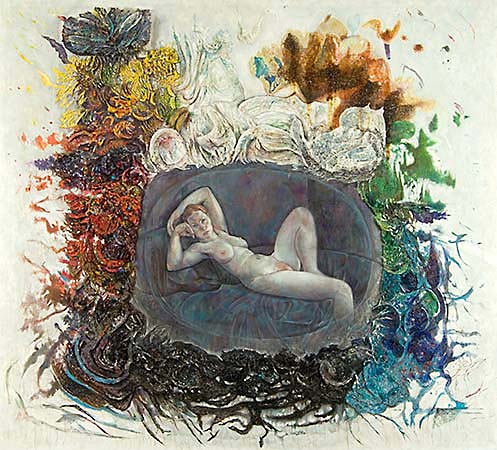
At the Still Point
At the still point of the turning world. Neither flesh nor fleshless; Neither from nor towards; at the still point, there the dance is, But neither arrest nor movement. And do not call it fixity, Where past and future are gathered. Neither movement from nor towards, Neither ascent nor decline. Except for the point, the still point… Burnt Norton by T.S. Eliot (from Four Quartets) |
For a long time, I’ve been fascinated by the texture, sensuality and signature of the artist’s palette.
At the Still Point attempts a dialogue between a nude and a palette, the colors echoing and bursting into each other. This painting deals particularly with the issue of process, bringing together many themes and threads that reside in my work.
This interest in paint and palette dates from a three year stay at the American Academy in Rome from 1976 – 1979. I had received the Rome Prize in Painting and had the luxury, for the first time, of working daily in a spacious studio at the Academy. As I painted, I found myself becoming fascinated by the sheer look and texture of my palette at the end of each day. My palette grew and expanded and I began collecting the paint for its own sake, creating small sculptural blocks from the daily residue.
In the last four years, I have literally used my palette as an integral part of my painting. Within this context, At the Still Point deals with the being and becoming of a work of art. A preliminary study helped me develop the spatial concept and color relationships, as well as the psychological counterpoint, for the large-scale work. Thus, the nude, lying within this cocoon-like space, finds herself in a state of creation. Both palpable and transparent, she occupies a deep and mysterious womb-like recess.
While working on the maquette or study for At the Still Point, I found myself remembering The Dybbuk, a play I had seen as a teenager. This is a story of a young, very beautiful woman who is haunted and physically occupied by a spirit. When she speaks, the deep, melancholy, male, voice of a rejected suitor is emitted from her lips. These scenes made me think of my working palette and the idea of it being “occupied” by a spirit or dybbuk. Within my palette, I began to envision a nude in the throes of some process of artistic realization, fighting to breathe and become alive. The combination of her corporeality and the sensuality of the paint began to form a mysterious conversation.
One wonders who is in charge: the artist manipulating the paint or the image demanding to be born?